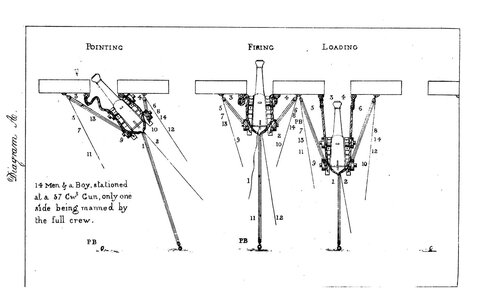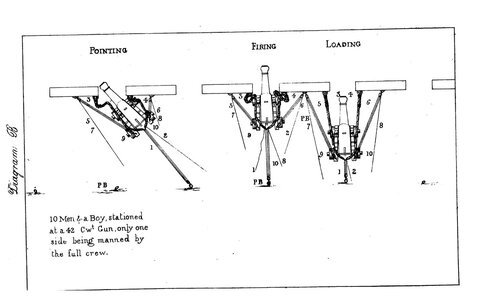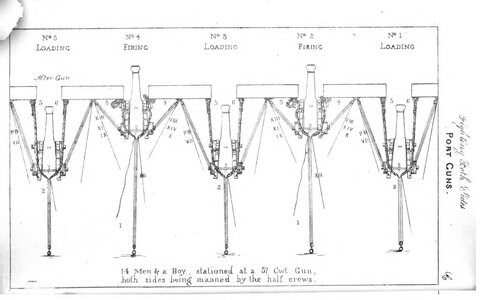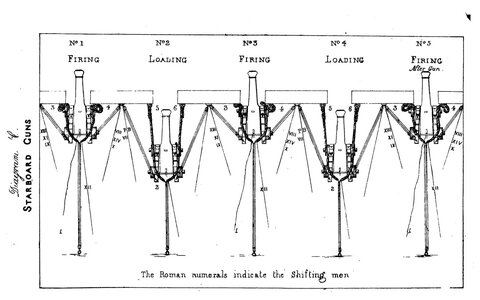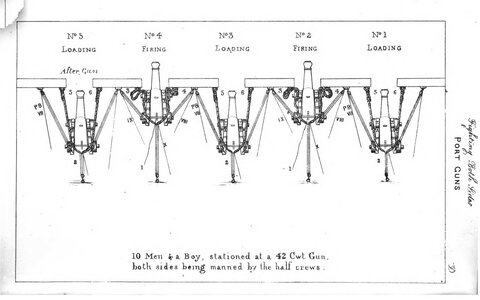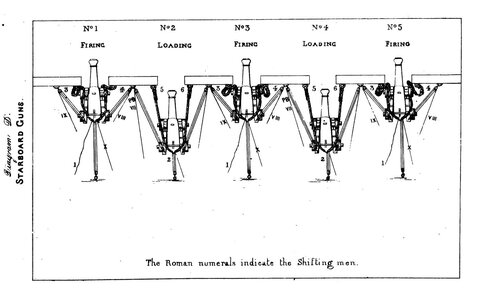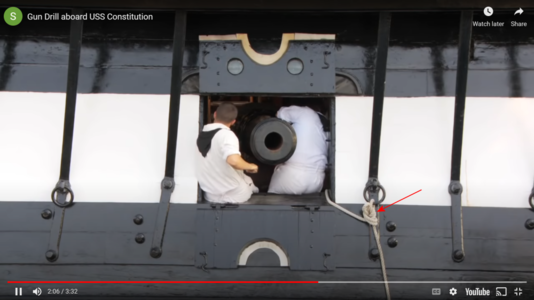I know how the tackles are used to bring back the gun to loading position, move it forward to firing position, move to the side for aiming and such, whether using the same sets of tackles or additional sets, and know the function of the breeching cables.
My question is: After the gun is in firing position, what, if anything, would be done to the tackles used to bring it forward? I've watched a number of Youtube videos, most with just breeching cables and no tackles, and some with tackles but either not firing or firing without shot. In short, most larger guns are not normally shot under full powder and shot conditions these days.
My point is that since the breeching cables stop the gun after recoiling, would the tackles used to position the gun be left taunt? If so, might they not break? Might the friction in the blocks when the gun moves quickly backwards cause the ropes to break, or would they thread back through the blocks quickly enough?
While I know nothing about how the gun tackles were used during firing, I can calculate a couple things. According to this source Victory's 32-pounders weigh 3.28 tonnes (barrel and carriage) each, or 7,232 pounds assuming these are metric tonnes (non-metric 2,000 lb tons are spelled ton - although the English may do things differently). And Broadside Cannon states the velocity of a 32-pound cannon ball would be 487 meters per second or about 1600 ft/sec. Now Newton's law of conservation of moment says that m1xV1 = m2xV2, so the velocity of the gun after firing would be V2 = m1xV1 / m2, where m1 = shot weight, V1 = shot velocity, m2 = gun weight and V2 = gun velocity. (Yes, I know the formula uses Mass, not Weight, but the conversions to mass cancel out, and even as an engineer, I'm uncomfortable with units of mass in the English system.) Thus:
Gun Velocity = 32 x 1600 / 7232 = 7.08 ft/sec. And it turns out 7 feet isn't a bad distance for the gun to recoil to until it was stopped by the breeching cable. With little or no friction, then, it would take one second for the gun to recoil to it's stopped position, somewhat more considering friction from trucks, ramping up the deck or friction from the gun tackles. That seems reasonable. And it certainly wouldn't kick back really quickly, like the barrels or actions of more modern recoiling guns. But I wouldn't want to be standing behind it!
So, I would think that at that velocity the gun tackles would be able to move with the gun, the ropes being pulled through at 3 times 7 = 21 ft/sec due to the Double/Single blocks. They'd probably get hot though? And they'd certainly be left loose, with 20' of extra cable ready to thread quickly through the block, and not tied up or neatly rolled up.
Any thoughts on the above? Anyone know if all gun tackles would remain in place during firing, ready to be pulled back, etc? Any thoughts on the physics of the system?
My question is: After the gun is in firing position, what, if anything, would be done to the tackles used to bring it forward? I've watched a number of Youtube videos, most with just breeching cables and no tackles, and some with tackles but either not firing or firing without shot. In short, most larger guns are not normally shot under full powder and shot conditions these days.
My point is that since the breeching cables stop the gun after recoiling, would the tackles used to position the gun be left taunt? If so, might they not break? Might the friction in the blocks when the gun moves quickly backwards cause the ropes to break, or would they thread back through the blocks quickly enough?
While I know nothing about how the gun tackles were used during firing, I can calculate a couple things. According to this source Victory's 32-pounders weigh 3.28 tonnes (barrel and carriage) each, or 7,232 pounds assuming these are metric tonnes (non-metric 2,000 lb tons are spelled ton - although the English may do things differently). And Broadside Cannon states the velocity of a 32-pound cannon ball would be 487 meters per second or about 1600 ft/sec. Now Newton's law of conservation of moment says that m1xV1 = m2xV2, so the velocity of the gun after firing would be V2 = m1xV1 / m2, where m1 = shot weight, V1 = shot velocity, m2 = gun weight and V2 = gun velocity. (Yes, I know the formula uses Mass, not Weight, but the conversions to mass cancel out, and even as an engineer, I'm uncomfortable with units of mass in the English system.) Thus:
Gun Velocity = 32 x 1600 / 7232 = 7.08 ft/sec. And it turns out 7 feet isn't a bad distance for the gun to recoil to until it was stopped by the breeching cable. With little or no friction, then, it would take one second for the gun to recoil to it's stopped position, somewhat more considering friction from trucks, ramping up the deck or friction from the gun tackles. That seems reasonable. And it certainly wouldn't kick back really quickly, like the barrels or actions of more modern recoiling guns. But I wouldn't want to be standing behind it!
So, I would think that at that velocity the gun tackles would be able to move with the gun, the ropes being pulled through at 3 times 7 = 21 ft/sec due to the Double/Single blocks. They'd probably get hot though? And they'd certainly be left loose, with 20' of extra cable ready to thread quickly through the block, and not tied up or neatly rolled up.
Any thoughts on the above? Anyone know if all gun tackles would remain in place during firing, ready to be pulled back, etc? Any thoughts on the physics of the system?



